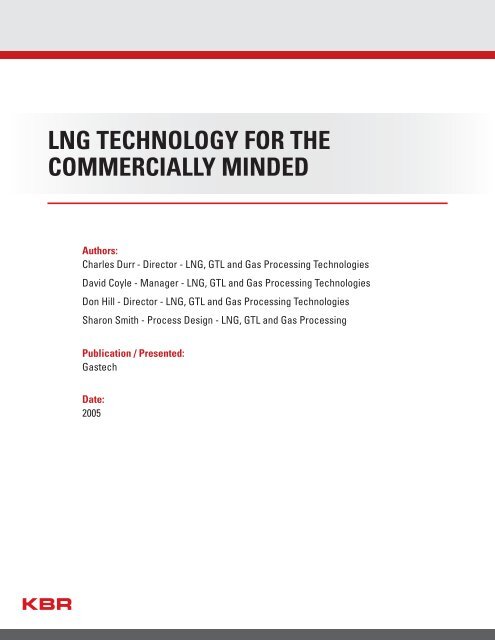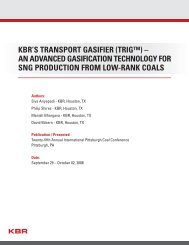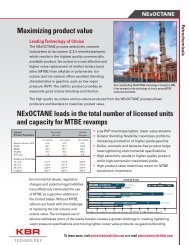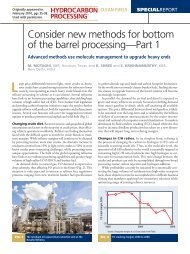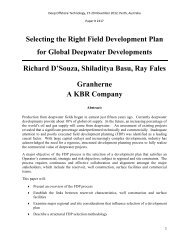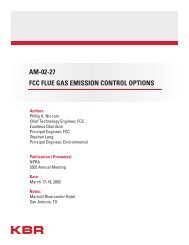LNG TECHNOLOGY FOR THE COMMERCIALLY MINDED - KBR
LNG TECHNOLOGY FOR THE COMMERCIALLY MINDED - KBR
LNG TECHNOLOGY FOR THE COMMERCIALLY MINDED - KBR
You also want an ePaper? Increase the reach of your titles
YUMPU automatically turns print PDFs into web optimized ePapers that Google loves.
<strong>LNG</strong> <strong>TECHNOLOGY</strong> <strong>FOR</strong> <strong>THE</strong><br />
<strong>COMMERCIALLY</strong> <strong>MINDED</strong><br />
Authors:<br />
Charles Durr - Director - <strong>LNG</strong>, GTL and Gas Processing Technologies<br />
David Coyle - Manager - <strong>LNG</strong>, GTL and Gas Processing Technologies<br />
Don Hill - Director - <strong>LNG</strong>, GTL and Gas Processing Technologies<br />
Sharon Smith - Process Design - <strong>LNG</strong>, GTL and Gas Processing<br />
Publication / Presented:<br />
Gastech<br />
Date:<br />
2005
ABSTRACT<br />
As the <strong>LNG</strong> industry continues to grow there is a steady influx of new players in the business. Most would classify<br />
themselves as technical or commercial with respect to their primary responsibilities, and for better or for worse, most<br />
have little exposure to the other discipline. Thus, there are process engineers with little understanding of the financial<br />
terms and conditions of a project, and commercial people who may understand technical aspects of their specific project<br />
but may not be aware of other available processing options.<br />
The purpose of this paper is to provide a basic technical understanding of the <strong>LNG</strong> route of gas monetization, but for the<br />
commercially minded. It is one thing to say that one technical solution is less costly than another, but what is the impact<br />
on the ability to finance the project, or the ability to sell the product? It is our goal to clarify some of today’s technical<br />
solutions and expected trends for the future, in a way that relates to someone with a commercial background. This<br />
clarification will be based on the definition of an <strong>LNG</strong> train, which is one continuous processing unit that condenses<br />
natural gas from a gaseous state to a liquid state.<br />
Some key technology issues identified and addressed in this paper are noted below:<br />
• GTL and <strong>LNG</strong> – How they are different, and how they are the same<br />
• Putting train size in perspective<br />
1. <strong>LNG</strong> Train Size – Economy of Scale<br />
2. <strong>LNG</strong> Process Drivers and Compressors – What are the limits?<br />
3. Electric Motor versus Gas Turbines for Refrigerant Compressor Drivers – What is behind this<br />
comparison?<br />
4. Ships – What is on the drawing board and how does this impact receiving terminal design?<br />
• Environmental challenges – What is the real impact of tighter regulations?<br />
• Safety – What are the measures taken to protect the public?<br />
• Offshore vs. Onshore<br />
• Product Specifications<br />
1. Associated Gas vs. Non Associated Gas<br />
2. Ethane/Propane Extraction – Should these facilities be on the liquefaction or receiving end?
I. Introduction<br />
Growth of the liquefied natural gas (<strong>LNG</strong>) industry has propelled this niche market into the mainstream of the natural gas<br />
business. So what exactly is <strong>LNG</strong>? Below is a simplified schematic of <strong>LNG</strong> in relation to gaseous products.<br />
96%<br />
LPG – Liquid Petroleum Gas<br />
NGL – Natural Gas Liquids<br />
<strong>LNG</strong> – Liquid Natural Gas<br />
© Gastech 2005 Durr 3<br />
3%<br />
1%<br />
0.1%<br />
Methane<br />
Ethane<br />
Propane<br />
Butane<br />
Pentane +<br />
LPG<br />
NGL<br />
Non Hydrocarbons (e.g. water, carbon dioxide, etc.)<br />
<strong>LNG</strong><br />
Natural<br />
Gas<br />
ex well<br />
Figure 1 Terminology and Constituents – Natural Gas and its Liquid Products<br />
The major obstacle in marketing natural gas is the large volume of the gas at ambient temperature and atmospheric<br />
pressure. As a result natural gas is seldom transported at such conditions. The most convenient method of transporting<br />
gas is at high pressure in a pipeline if the distances are short. The general rule of thumb is that pipeline versus <strong>LNG</strong><br />
transport economics break even at approximately 3200 km onshore and 1600 km for offshore. At distances greater than<br />
these <strong>LNG</strong> is usually more attractive economically, as shown in Figure 2.<br />
Figure 2 <strong>LNG</strong> economics improve as distance to market grows [Ref. 1]<br />
Chilling natural gas down to -160 o C where the gas becomes a liquid reduces the volume by a factor of roughly 600. This<br />
volume reduction is what has made <strong>LNG</strong> the method of choice for transportation over long distances. However, the low<br />
temperature is a disadvantage for several reasons. First is the fact that reducing the temperature of the gas to -160 o C<br />
requires energy and expensive processing equipment. Typically about 10% of the natural gas entering the plant must be<br />
burned to provide the energy needed for refrigeration. There are ways to make processing more efficient as will be<br />
discussed later, but the energy needed is still substantial and the refrigeration machinery is expensive.<br />
Secondly, low temperature processing requires special materials. Pipelines operating at ambient temperature can be<br />
made of carbon steel, while <strong>LNG</strong> must be stored in aluminum, stainless steel, high nickel steel, or other more expensive<br />
materials. Recent current prices for carbon steel are about $0.50/lb while 304 SS (stainless steel) is about $2.30/lb.<br />
Thus, the product storage and transportation costs are relatively high for <strong>LNG</strong> compared to transportation of other liquid<br />
hydrocarbon products such as diesel or gasoline.
II. Gas Monetization Options<br />
There is a high level of interest in ambient temperature transportation methods such as gas-to-liquids (GTL) (conversion<br />
of natural gas into LPG, naphtha, diesel, and gas oil products), not only because of the relative ease in handling ambient<br />
temperature liquids, but also because there is a larger product market capacity versus <strong>LNG</strong> . A world scale <strong>LNG</strong> plant<br />
making 10 million metric tons per year (MTPA) might contribute 6% to the total <strong>LNG</strong> world market; however, a GTL<br />
project handling the same amount of gas will add only a 0.3% increment to the total world liquid fuels market.<br />
GTL technology is completely different from <strong>LNG</strong>, yet GTL projects still have much in common with <strong>LNG</strong>. Both<br />
technologies are based on getting a remote gas to market and involve large, complex projects in difficult locations.<br />
In <strong>LNG</strong> production, natural gas does not go through any chemical reactions; rather, the gas only changes from gas to<br />
liquid. In GTL production, the natural gas goes through three process steps, each involving a chemical reaction as<br />
shown in Figure 3.<br />
In summary, in the first step, methane (which contains a single carbon with four hydrogens) splits, with the addition of<br />
oxygen, into carbon monoxide and hydrogen. In the second step this carbon monoxide and hydrogen is then recombined<br />
to form long chains of carbons connected to each other. However the long chains that are formed are too long to use as<br />
a practical fuel- it is more like a wax. Hence the third and final step is to break the long chains of carbons into a more<br />
practical number of chains such as for diesel (11-19 carbons).<br />
Figure 3 Simplified GTL Chemistry<br />
Typical project capital cost numbers are approximately $200 per metric ton per year of <strong>LNG</strong> product and $500 per ton per<br />
year of GTL product, although these figures are both highly variable depending on project scope and site. In terms of<br />
heating value, these convert to capital costs of approximately $3.88 per MMBTU per year of <strong>LNG</strong> product and $11.00 per<br />
MMBTU per year of GTL product. Hence the higher initial cost of GTL production compared to <strong>LNG</strong> must be compensated<br />
for by the lower shipping and terminal costs for GTL. Because of the special materials needed to handle cryogenic <strong>LNG</strong>,<br />
the transportation costs for <strong>LNG</strong> are higher than for GTL. An <strong>LNG</strong> tanker with 135,000 m 3 capacity costs about $170 MM<br />
while a GTL carrier of the same size costs about $55.2 MM.<br />
© Gastech 2005 Durr 4
III. <strong>LNG</strong> and Economy of Scale<br />
The first baseload <strong>LNG</strong> train built in Arzew, Algeria in 1964 had a capacity of 0.4 MTPA. Since that time, the single train<br />
capacity has grown beyond 5 MTPA and at least one project is now nearing the engineering, procurement and<br />
construction (EPC) phase based on 7.8 MTPA. Figure 4 below shows the trend of greater train capacity over time.<br />
Figure 4 Trend of <strong>LNG</strong> Train Capacities Over Time<br />
The reason for the trend towards greater train size is economy of scale. Figure 5 below shows a typical cost breakdown<br />
for an <strong>LNG</strong> liquefaction plant. Although the actual breakdown depends on site, much of the cost will always be in the<br />
storage and loading area.<br />
Relative Capital Cost per<br />
MTPA of <strong>LNG</strong><br />
1.2<br />
1<br />
0.8<br />
0.6<br />
0.4<br />
0.2<br />
0<br />
Economies of Scale for <strong>LNG</strong> Plants<br />
5 Mtpa 9 Mtpa<br />
Process Units Utilities&Offsites<br />
<strong>LNG</strong> Storage & Loading Total Plant Cost<br />
Figure 5 Approximate <strong>LNG</strong> Plant Cost Allocation<br />
The size of storage and loading facilities depends to some extent on the plant capacity, but typically has a greater<br />
dependence on ship size. All things being equal, a plant making more <strong>LNG</strong> will have more frequent ship loadings, but the<br />
product loading rate remains the same, and storage capacity will only increase slightly. The ability to increase train<br />
capacity while maintaining constant storage and loading size improves the overall economics.<br />
The cost difference between a single train and two smaller trains is substantial. The <strong>LNG</strong> train typically represents 50%<br />
of the total facility cost for a single train facility. If the train is split into two parallel units the train cost increases by<br />
about 35-40% which increases the total facility cost by 17-20%.<br />
Splitting process units into multiple trains is sometimes done to reduce the impact on production when a single unit goes<br />
down. Production is either 0% or 100% in a single train unit while a two-train unit usually functions at 50% or 100%.<br />
Only in extremely rare cases will the production for the two-train unit be 0%.<br />
At the same time it is important to realize that overall availability remains the same. The reason is that in a two-train<br />
unit a single failure reduces production by 50%, but there are twice as many items to fail. Production is nearly the same<br />
over the long run whether the plant is single train or multiple trains.<br />
© Gastech 2005 Durr 5
% <strong>LNG</strong> Production<br />
120<br />
100<br />
80<br />
60<br />
40<br />
20<br />
0<br />
<strong>LNG</strong> Production versus Time<br />
4 days 4 days 8 days 8 days 4 days 4 days 8 days 8 days<br />
Graph shows both scheduled and unscheduled days,<br />
assumed at 24 days per year per train<br />
4 days 8 days 4 days<br />
8 days<br />
365 Days<br />
Single Train Plant Parallel Trains Plant<br />
Figure 6 Single and Multiple Train Availability<br />
Equipment developments have, for the most part, kept pace with the increases in train capacity. Equipment selection<br />
trends also indicate changes in philosophy that extend beyond a mere response to capacity increases. These trends are<br />
discussed further as follows:<br />
A. Steam Turbines vs. Gas Turbines<br />
Most of the earlier plants were steam turbine driven, though there were some exceptions. Steam turbines do<br />
have some advantages over gas turbines, such as providing a designer the ability to design over wide ranges of<br />
power and speed. Gas turbines on the other hand, come in discrete sizes such as “Frame 5” and “Frame 6”.<br />
Steam turbines, unlike gas turbines, can run for years and years without scheduled maintenance.<br />
There is an unmistakable trend toward gas turbines for a variety of reasons as discussed below.<br />
Percentage of Producing Capacity<br />
100%<br />
1. Cost<br />
80%<br />
60%<br />
40%<br />
20%<br />
0%<br />
<strong>LNG</strong> Refrigerant Compressor Drivers<br />
1960 1970 1980 1990 2003<br />
Steam Frame 5 Frame6/7 Electric Aeroderivative<br />
© Gastech 2005 Durr 6<br />
10%<br />
90%<br />
2%<br />
41%<br />
23%<br />
32%<br />
Figure 7 Trends in <strong>LNG</strong> Refrigerant Compressor Drivers<br />
Capital equipment cost savings for a gas driven/air cooled plant average 7%. This savings is further<br />
increased for the plant total installed costs (TIC) to 14-15% when the seawater system civil installations<br />
(typical for steam driven plants) are included.<br />
Fuel consumption also drops by almost 8% with the gas driver/air cooled plant thus reducing ongoing<br />
operation costs.<br />
2. Equipment Count<br />
Steam drivers add to equipment count in a major way, as shown in Table 1. The table indicates the<br />
number of items needed in a steam driven plant beyond those needed for gas turbine drivers.<br />
2%
Table 1 Equipment Count Additions for Steam Turbine Drivers (per train)<br />
System<br />
Heat Exchangers (Surface<br />
Condensers)<br />
5<br />
Seawater Distillation 16<br />
Steam 17<br />
Condensate Handling and<br />
Treatment<br />
52<br />
Total 90<br />
© Gastech 2005 Durr 7<br />
Additional Equipment Items<br />
The additional 90 items are significant considering that a gas turbine driven train typically has about 140<br />
items. Furthermore, if a seawater system is installed instead of air cooling another 64 items are needed.<br />
A steam driven plant requires more operating attention and maintenance effort which also contributes to<br />
the trend towards air cooling shown in Figure 8.<br />
<strong>LNG</strong> Production Capacity<br />
1.00<br />
0.80<br />
0.60<br />
0.40<br />
0.20<br />
0.00<br />
3. Plot Space<br />
Refrigerant Cooling Media Trends<br />
10%<br />
35%<br />
55%<br />
37%<br />
7%<br />
52%<br />
1960 1970 1980 1990 2003<br />
4%<br />
Seawater Freshwater Air Hybrid<br />
Figure 8 Trends in Refrigerant Cooling for <strong>LNG</strong> Plants<br />
The new generation of gas turbine driven <strong>LNG</strong> plants require a smaller foot print than steam driven<br />
plants as shown in the figure below.<br />
Malaysia <strong>LNG</strong><br />
Dua<br />
Satu<br />
Project<br />
M<strong>LNG</strong> Satu<br />
(Trains 1, 2, 3)<br />
M<strong>LNG</strong> Dua<br />
(Trains 4, 5, 6)<br />
Malaysia <strong>LNG</strong><br />
Train<br />
Capacity<br />
(MTPA)<br />
2.1<br />
2.6<br />
Turbines<br />
Steam<br />
Gas<br />
Innovative design for Malaysia<br />
<strong>LNG</strong> Dua reduced train plot<br />
space by 40%, as compared to<br />
Malaysia <strong>LNG</strong> Satu.<br />
Figure 9 Turbine Driver Selection and Effect on Plot Area for <strong>LNG</strong> Production Facilities<br />
Source: Photos courtesy of Malaysia <strong>LNG</strong> Sdn. Bhd. and Malaysia <strong>LNG</strong> Dua Sdn. Bhd.
B. Electric Motor Driven Plants<br />
In recent years, there has been increasing interest in using electric motors as drivers for the refrigeration<br />
compressors. Electric motor drivers in world-scale <strong>LNG</strong> plants can increase plant availability by about 3-4%.<br />
This option can require about $90-100 MM additional investment for a 3.5% increase in annual production<br />
(315,000 TPA for 9 MTPA plant).<br />
The Snohvit project in Norway will be the first <strong>LNG</strong> plant to have motor drivers. The site is unusual (for an <strong>LNG</strong><br />
Project) in that there is access to the national power grid. Nonetheless, to achieve maximum reliability, the plant<br />
is designed to be self-sufficient and will generate its own power during normal operation.<br />
C. Main Cryogenic Heat Exchangers<br />
Basically there are two styles of main cryogenic heat exchangers (MCHE) used in liquefaction processes: spiral<br />
(or coil) wound exchangers (SWHE) in a pressurized shell or plate-fin (also known as brazed aluminum) (PFHE) in<br />
cold boxes. The style of exchangers is related to the type of liquefaction process employed, but ultimately the<br />
selection is by the plant owner.<br />
There is little difference in cost and schedule between most liquefaction processes. The heat exchange<br />
equipment is a small portion of the overall cost, and the process drivers are not tied to a specific process (for<br />
example, GE Frame 5 and Frame 7 gas turbines can be employed in all commercial liquefaction processes). As<br />
long as the process efficiencies are similar the overall costs will also be similar and the selection of process is an<br />
exercise in matching equipment selections with capacity targets.<br />
D. Storage<br />
There are several different types of storage tanks to choose from, including single, double, full containment, and<br />
in ground membrane type storage. The decision of which to use is often based on land availability. All <strong>LNG</strong><br />
storage types have secondary spill containment and the primary difference between single, double, and full<br />
containment is the secondary containment. The single containment tank has a dike for secondary containment<br />
and this type of tank requires the most land.<br />
The double containment tank has an outer concrete wall for secondary containment, and therefore requires less<br />
land. The full containment tank is similar to the double containment but also has a roof that is capable of<br />
handling cryogenic temperatures, and contains not only the liquid spill but also vapor. Figure 10 below shows<br />
the cost factors and schedule requirements for each type; however, the cost factors do not take into account the<br />
cost of the land or dikes. Hence, including these factors may alter the overall cost relationships. The table also<br />
shows a PC-PC type of tank which is a double concrete tank design that has yet to be installed in a baseload<br />
facility.<br />
Figure 10 Relative Costs and Schedule Impacts of Various <strong>LNG</strong> Storage Tank Types<br />
© Gastech 2005 Durr 8
A facility with 2 x 160,000 m 3 tanks requires about 220-250 acres of land if the tanks are single containment.<br />
Most of this land is not needed for the storage and containment, but the land is needed to comply with thermal<br />
radiation limits at the plant fence line. For the same criteria full containment storage requires only 70-80 acres of<br />
land, based on a collapsed roof scenario. However, at many locations the governing authorities do not consider<br />
a full containment roof failure a credible scenario and in such cases an entire receiving terminal can fit within a<br />
25 acre plot. See Figure 11 for a graphical representation of these indicative single and full containment plot<br />
requirements.<br />
245 Acres:<br />
Land required for Single Containment Storage.<br />
82 Acres:<br />
Land required for Full Containment Storage.<br />
25 Acres:<br />
Land required with no roof<br />
failure consideration.<br />
Figure 11 Indicative Plot Requirements Based on Thermal Radiation Criteria<br />
Like other equipment in the <strong>LNG</strong> industry, storage tank capacities have grown. The plot below (Figure 12) shows<br />
storage tank size over time for <strong>LNG</strong> plants worldwide. Tank sizes of 140,000-160,000 m 3 are now common, and<br />
trending to capacities up to 200,000 m 3 .<br />
E. Shipping<br />
Capacity (m3)<br />
200,000<br />
180,000<br />
160,000<br />
140,000<br />
120,000<br />
100,000<br />
80,000<br />
60,000<br />
40,000<br />
20,000<br />
0<br />
<strong>LNG</strong> Storage Tanks in <strong>LNG</strong> Plants<br />
1960 1970 1980 1990 2000 2010<br />
Single Full<br />
Figure 12 Trends in <strong>LNG</strong> Storage Tank Capacities<br />
As with the <strong>LNG</strong> liquefaction plants and storage tanks, <strong>LNG</strong> ships have also grown in size. In the last ten years<br />
the typical size has grown from 125,000 m 3 to 145,000 m 3 , and sizes of 200,000 m 3 to 250,000 m 3 are currently<br />
proposed by ExxonMobil. Larger sizes improve economy of scale, but questions remain on whether today’s<br />
marine facilities can receive the larger ships and if so, the extent of modifications to existing terminals that might<br />
be required.<br />
© Gastech 2005 Durr 9
Many facilities can be modified for relatively low cost, but the key variable is water depth. If the water depth is<br />
not sufficient the cost jumps by an amount that depends on the marine contours and conditions and site location,<br />
and in such cases the cost can have a measurable economic effect.<br />
IV. Environmental Challenges<br />
Reducing environmental impact is one of the main drivers for growth of the <strong>LNG</strong> industry. Burning natural gas is much<br />
cleaner than burning coal or liquid petroleum products. Figure 13 below shows a comparison of CO2, SOx and NOx<br />
emissions for the three different fuels. In all three categories natural gas has the clear advantage. This and the strong<br />
global growth in electric power generation explain much of the steady growth in natural gas and <strong>LNG</strong> demand over the<br />
years.<br />
© Gastech 2005 Durr 10<br />
[Ref 4]<br />
Figure 13 Comparison of emissions of by-products of fossil fuel combustion<br />
Reducing the environmental impact of the <strong>LNG</strong> plant itself is also a concern. The <strong>LNG</strong> plant has vapor emissions from<br />
process vents and driver exhausts, liquid effluents from sumps and drains and cooling medium return, and solid waste<br />
from spent molecular sieve and mercury removal catalyst. Compared to other chemical processes the <strong>LNG</strong> plant is<br />
relatively clean with few hazardous materials. Still, the industry strives to reduce environmental impact by applying one<br />
or more of the following methods:<br />
• To reduce fuel consumption, use combined cycle power wherein the gas turbine exhaust heat generates<br />
steam for power generation (See Figure 14).<br />
Amount of Feed Gas<br />
Consumed by Process<br />
12%<br />
10%<br />
8%<br />
6%<br />
4%<br />
2%<br />
0%<br />
Simple vs. Combined Power Cycle<br />
"Auto-Consumption"<br />
Simple Cycle Power Combined Cycle Power<br />
Figure 14 Simple Cycle vs. Combined Cycle Power<br />
• Use dry low NOx (DLN) burners in gas turbines. The large Frame 7 gas turbines without DLN generate about<br />
150-160 PPM of NOx in the exhaust gas, and the smaller Frame 5’s generate about 125 ppm. With DLN<br />
burners the NOx drops to 25 ppm for both types of gas turbines. Frame 7 gas turbines now come with DLN<br />
as a standard accessory (ordering without DLN will save little if any cost). For the smaller Frame 5 gas<br />
turbines DLN remains an option.
NOx Concentration, ppm<br />
160<br />
120<br />
80<br />
40<br />
0<br />
NOx Output from Gas Turbine Configurations<br />
No DLN With DLN<br />
Figure 15 NOx Reduction with DLN Burners<br />
• Consider air cooling instead of seawater cooling to avoid any impact on marine life. Designing the seawater<br />
system to World Bank guidelines minimizes impact on the marine environment, but in some cases selecting<br />
air cooling speeds up the approval process. Also, for many sites air cooling will be a less expensive option.<br />
V. Safety<br />
Safety is such a significant topic that it would be possible to make different aspects of safety the subject of every paper<br />
in this conference. For the sake of brevity this discussion will cover safety only at the highest level. At the same time it<br />
must be mentioned that safety in the design, construction, and operation of <strong>LNG</strong> facilities is a key focus area for all<br />
involved, as safety is a core value.<br />
The main safety objectives when designing an <strong>LNG</strong> facility are:<br />
• Protect the general public<br />
• Protect the plant personnel<br />
• Limit the extent of property loss in the event of a hydrocarbon spill<br />
All of these objectives are achieved while considering that a cryogenic hydrocarbon spill vaporizes and the cloud expands<br />
as the spill is warmed by the surrounding environment. The measures used to avoid spills and to mitigate the<br />
consequences when they occur are shown in Figure 16.<br />
© Gastech 2005 Durr 11
Primary Containment<br />
Secondary Containment<br />
Safeguard Systems<br />
Separation Distances<br />
Industry Standards / Regulatory Compliance<br />
Figure 16 <strong>LNG</strong> Safety Measures<br />
• Primary Containment<br />
o First and most important safety requirement<br />
o Achieve by employing suitable materials for storage tanks and other equipment, and by<br />
appropriate engineering design throughout<br />
• Secondary Containment<br />
o Ensure that if leaks or spills occur, the <strong>LNG</strong> can be contained and isolated.<br />
o For onshore – dikes and berms, or reinforced concrete tanks around inner tanks<br />
• Safeguard Systems<br />
o Minimize releases of <strong>LNG</strong> and mitigate effects of release - both active and passive systems<br />
o Use gas, liquid and fire detection to rapidly identify any breach in containment<br />
o Use remote automatic shut off systems to minimize leaks and spills in case of failures<br />
• Separation Distances<br />
o Minimum distances between equipment and the plant fence line based on thermal radiation,<br />
vapor dispersion, and blast pressure criteria<br />
o Codes and regulations siting facilities at a safe distance from adjacent industrial areas,<br />
communities and other public areas<br />
• Industry Standards/Regulatory Compliance<br />
VI. Offshore <strong>LNG</strong><br />
Offshore <strong>LNG</strong> options are currently under development, though none are commercialized as of this writing (however<br />
Exelerate Energy is on track to come on line on the US Gulf Coast by the time this paper is published). The offshore<br />
technology solution might be cost effective for liquefaction if getting the gas to shore requires long pipelines in deep<br />
water. On the receiving end the offshore option looks attractive in cases where land is difficult to acquire or where local<br />
opposition could delay or stop an onshore development.<br />
Generally speaking an offshore <strong>LNG</strong> facility costs significantly more than the same facility installed onshore. Yet some<br />
onshore sites are difficult or expensive because of long jetties or breakwater requirements (which can add over $100 MM<br />
to the cost of some sites). In such cases the penalty for moving from onshore to offshore may not be too severe.<br />
© Gastech 2005 Durr 12
VII. Product Specifications<br />
Natural gas is primarily methane, with some ethane, propane, butane and heavier hydrocarbons. The relative amounts<br />
of these heavier components have an effect on the natural gas properties, namely heating value (HHV) and Wobbe Index<br />
(WI). The heating value is a measure of the combustion heat available for a given amount of gas molecules. The<br />
Wobbe Index is a relative measure of how much heat will be provided through a burner tip at a fixed pressure. More<br />
heavies result in higher heating value and higher Wobbe Index.<br />
The globalization of natural gas is a positive development for the <strong>LNG</strong> industry since baseload <strong>LNG</strong> is traded<br />
internationally. But this development is also leading to product specification problems related to “gas interchangeability.”<br />
When gas is produced for a local market the specifications can be anything because the gas consumers will have<br />
equipment and appliances designed for that local specification. However, when that same gas is exported to a different<br />
consumer market, the specifications may not be consistent.<br />
This is the case with the European, Pacific Rim, UK and US markets as shown below in Figure 17. The wide differences<br />
in the specifications lead to legitimate concerns on everything from power generation difficulties to catching the chef’s<br />
apron on fire. In other words, the gas going to one market is not interchangeable with the gas going to another market,<br />
especially if one is targeting both the Pacific Rim and US markets.<br />
In the absence of gas conditioning, the <strong>LNG</strong> product is close in composition to the gas entering the plant. The gas can<br />
come from two sources: associated and non-associated. Associated gas is released during oil production when the oil<br />
drops in pressure as it leaves the well. Associated gas has a high concentration of heavy components and must have<br />
propane and butane (also known as liquid petroleum gas, LPG) extracted to meet most, if not all, natural gas<br />
specifications globally.<br />
HHV (MJ/m 3 n)<br />
© Gastech 2005 Durr 13<br />
48<br />
47<br />
46<br />
45<br />
44<br />
43<br />
42<br />
41<br />
40<br />
39<br />
38<br />
37<br />
36<br />
Japan Korea USA UK France Spain<br />
Figure 17 Gas Interchangeability<br />
Example: gas HHV within<br />
Pacific Rim specs,<br />
but not US/UK specs<br />
Specifications for<br />
France and Spain<br />
originated with<br />
international trade and<br />
thus tend to be wider.<br />
Example: gas HHV within<br />
US/UK specs,<br />
but not Pacific Rim specs<br />
With the broad European specifications and large Pacific Rim market, gas interchangeability has not been a big issue until<br />
recently. With the expected growth in UK and US markets the industry now has to grapple with interchangeability.<br />
Options include LPG extraction or injection at the liquefaction or receiving end, or injection of an inert gas such as<br />
nitrogen at the receiving end.<br />
For the time being, the industry is heading in a direction of conditioning the gas at the receiving end. This provides the<br />
receiving terminal with more relatively inexpensive options for <strong>LNG</strong> supply. However on the liquefaction end, some<br />
owners are looking into LPG injection based on a long term supply agreement of sufficient size to justify the effort.<br />
Although gas interchangeability is important from gas marketing and technology perspectives, the cost of providing<br />
interchangeability is relatively low and it is probable that there will be no single industry answer. Some liquefaction<br />
plants will have the flexibility built in and some will not, and the same will be true on the receiving end.
VIII. Summary<br />
<strong>LNG</strong> continues to be an attractive means for monetizing remote gas reserves, and the future appears bright as<br />
manufacturers continue to improve technology and reduce <strong>LNG</strong> costs. The industry has been responsive to<br />
environmental and safety concerns of the societies it serves, and continues to lead the way in developing health, safety,<br />
and environmental practices. It will be interesting to watch and participate in the immediate future of <strong>LNG</strong> as the<br />
industry addresses onshore/offshore and gas interchangeability issues to increase natural gas trade on a global basis.<br />
References<br />
1. Gas Treatment, Liquefaction and Storage by Heinz Kotzot, <strong>KBR</strong> Process Manager, ‘Overview of the <strong>LNG</strong> Industry’<br />
session GPA Convention March 2003 San Antonio Texas<br />
2. <strong>KBR</strong> Internal Study, Heinz Kotzot, <strong>KBR</strong> Process Manager, 2002.<br />
3. The Institute of Applied Energy, Report on Evaluation of Effect of Thermoelectric Power Generation on the<br />
Atmosphere (March 1990) for CO2, OECD/IEA, Natural Gas Prospects to 2010 (March 1987) for NOx and SOx.<br />
4. “<strong>LNG</strong> Quality and Market Flexibility Challenges and Solutions” by Yves Bramoulle of Total Gas & Power, Pascale<br />
Morin and Jean-Yves of Total Exploration & Production. Paper presented at <strong>LNG</strong>14, March 2004<br />
5. “Selecting the Optimal Process for C2+ Extraction From <strong>LNG</strong>” by Charles Durr, David Coyle, Joseph Cho, Stanley<br />
Huang, all of <strong>KBR</strong>. Paper presented at AICHE 2004<br />
© Gastech 2005 Durr 14


